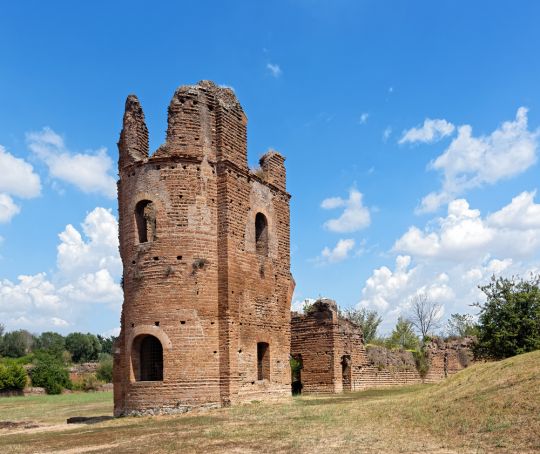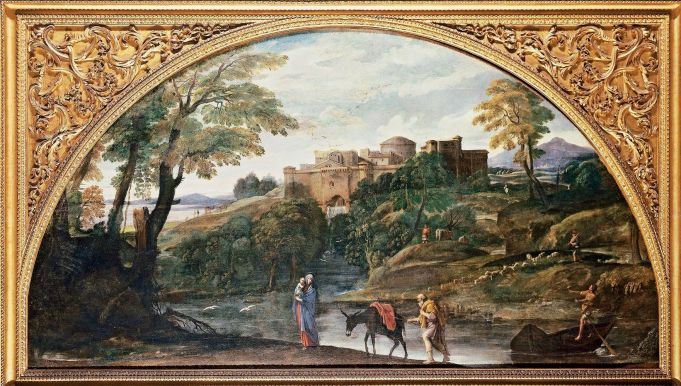Take a day-return train trip from Rome around an historically-rich area framed by the Alban Hills, the Sabine Heights and the Apennines.
By Martin Bennett"To stray in spirit better through the land/ This morn of Rome and May," recommends Robert Browning’s poem Two in Campagna. Or for €5, in whatever month, one can take a train, a day-return from Guidonia to Tiburtina.
First stop for Romeward journey is Bagni di Tivoli, bringing home how this often-neglected hinterland was part-and-parcel with Rome's urban centre. Those variously-sized segments of smoothly-cut travertine visible from the carriage window are the same material that Emperor Vespasian had elephanted in for his Flavian amphitheatre/ Colosseum. Another instance of how all roads lead to Rome.
Down the line is Ponte di Nona, named after Rome’s ‘ninth mile’ from the Forum. The river Aniene’s tributary below has vanished into twinkling air. Yet the ancient bridge still stands, its central section from the first century BC. Where commuters now drive to work, picture foot-slogging legionnaires along Via Prenestina’s ex-consular road. "Rome’s ghost since Rome’s decease," Browning, looking across the ruin-strewn landscape, compacts milennia into a phrase.

Other villas sprouted along river banks, for Roman historian Cato the Elder the ideal venue. By the Aniene several have been unearthed, the river both scenic and a ready means of transport, as example Villa Ripa Mammea and Villa Cervara. Nearby towers the remains of a quarry once supplying ancient Rome’s upmarket building boom.
All well and good, idyllic ‘otium’, the Romans' 'R&R'guaranteed. However with Barbarians at the gates, soon la Campagna would never be the same. True, as the empire shrunk and foodstuffs became scarce, Campagna/ Ager Romanus, previously used for pasture, enjoyed a brief lease of agricultural life, its crops making up the shortfall of Rome’s lost provinces. This nothwithstanding the fact that with Constantine’s move to the east (together with a mass of patricians and artisans), many villas had passed to the now official Church which now officially established became a big-time landowner.
Sacred pagan groves
The most infamous blow came in 537. Vertiges, the Visigoth king, blocked the aqueducts in the Campo Barbaro (present-day Parco dell’Appia Antica), using two of them, filled with ‘extra mud and stones’ (c.f. Latin historian Propinius), to form a trapezoid-shaped fortress. Hydrology kaput, Rome’s idyllic outskirts/newfound breadbasket turned swamp. Blame has been heaped, longer term, on the new religion for the felling of Campagna’s sacred pagan groves, with adverse ecological effects stretching millennia.Goths then Lombards came and left. To the new Church landlords more important than seasonal profit from agriculture was the fact of permanent ownership. "A diseased sterile wetland," notes one Grand Tourist, ‘er deserto’ as it was nicknamed by hard-pressed locals. One 18th-century author even claims that popes gloried in Campagna’s desolation, its serving to redirect pilgrims or tourists to the better-maintained wonders of the Eternal City.
Actually the eighth-century Pope Adrian undertook aqueduct reconstruction, then in 1585 Sixtus V, redirecting Aqua Alessandria, built the Aqua Felice. Mediaeval times saw a spate of castle-building by papal vassals. First along the coast to stop the Saracens (such as the 10th-century Tor Vaianica) then Normans, and next inland, to defend feuding land-owning families from each other (11th-century Tor Sapienza, now naming also a train station en route.)
Wreaking as much damage as any horde (and one of multiple factors behind the empire’s fall), is malaria, formerly known as ‘tertian’ or ‘quartan’ fever. The symptoms, if not the cause, were recognised by Hippocrates (c4th BC), and later described, under Tiberius’s reign, by Latin writer Celsus. Pliny the Elder links the health of the farmworkers at his different villas to seasonal flooding.Only in the 1890s would it be possible to claim "Rome’s history has largely been written by the mosquito", to quote a writer at the time. The seeming exaggeration received more credence in the late 1990s when American archaeologist Davis Soren came upon a children’s graveyard on Lugnano, 95 km from the capital. Dating to 450 AD, 40 skeletons were found, many still- or newly-born, then as now, a particularly vulnerable group where malaria is concerned.
More sinister still were fragments of beheaded and dismembered puppies at the same site. Along with traces of honeysuckle, an old ‘tertian’ remedy. The puppies suggested the parents’ having resorted to pagan sacrifice in propitiation. Indeed, the Romans characterised malaria/ ‘tertian’ as an evil spirit. No surprise that the skeletons had been blocked off by strategically-placed slabs. Nor that Quintus Serenus under Caracalla’s reign reports ‘abacadabra’ as a spell, worn round the neck as talisman/antidote.
Concurrently to Soren’s findings Professor Coluzzi, former hygiene professor at La Sapienza, was gathering evidence for his theory that malaria reached Campagna via Rome’s north African colonies, Sardinia a mid-way point, the plasdomium / malaria parasite being present in ships’ water-barrels.
As in a crime series, proof hardened after DNA tests; British science historian Davis Sallares managed to extract malarial traces from a three-year-old girl’s thighbone, (Skeleton 36 of those previously excavated by Sorene.) Malaria as an element in Rome’s decline passed from wild speculation to solid fact. The search is now on for an equivalent graveyard for adult victims.
Another scourge, over time, were brigands. On Via Giulia, SS. Maria dell’Orazione e la Morte’s facade includes, with winged skulls, a plaque dated 1694: "Offerings for the poor dead collected from the Campagna." Thus the church’s eponymous order was devoted to retrieving bodies of brigandage’s abandoned victims. Countryside as deathtrap. Yet from an artistic viewpoint it was a cradle.

Artists
A painting by Baroque master Pietro da Cortona in the Capitoline museum depicts a view for its own sake. Residents of France’s Villa Medici in Rome, Poussin and Claude Lorrain depicted rural stretches bathed in a sumptuous golden light later admired by Turner who, approaching Rome, would jot in his diary, "my first bit of Claude."Throughout, stock mythological figures shrink in size as the natural background dominates traditionally classical narrative. Gods and goddesses upstaged by foliage and light-effects, another kind of flora, might be a summary. With Hackert then Corot (cf. his depiction of the Claudian acqueduct) human figures disappear entirely. Aided by viridian’/ chromium oxide, a state-of-the-art very expensive colour, painting al vero prefigures photography.
The artist in the same ‘Grand Tour’ period is redeployed as supplier of souvenirs. Welshman and ‘Father of British Landscape Painting’, Richard Wilson describes his Campagna views as ‘good breeders’, such was their demand. Most upmarket ‘selfie’ of all is surely Tischbein’s portrait of Goethe. Millennia in his ken, the writer reclines on a bench/ plinth? Alongside is a frieze of Iphigenia in Tauris, matching Goethe’s then work-in-progress, while at his shoulder is Cecilia Metella’s tomb. Grand tourist par excellence. No matter changes in taste or style, Campagna had enough to keep painters busy for years.The early 1900s brought the ‘XXV’ group of painters, referring to the number of its members. Sundays, with ritual stop-off at local trattoria, they would make their excursion. Unlike Claude and Poussin, their work was deliberately realistic, with a social agenda documenting the inhabitants’ poor health and indirectly inspiring Mussolini's 1920s-30s bonifica / draining projects. Thanks also to the discovery of quinine, by the 1940s Campagna had become fully-habitable; towns such as Guidonia (named after the air-ace Alessandro Guidoni) sprang up over mouldered estates and castles.
Back on our day-return, train-window, then, as alternative art-gallery. To watch-towers, aqueducts and age-old cypresses, add the odd pylon and mechanically-produced rolls of hay.
Gaze left at the siding at Bagni di Tivoli: rust-streaked yellow repair engine is overrun by clumps of in-blown vegetation. A reminder that Campagna’s ever-ready to reassert itself. "Such letting nature have her way/ While heaven looks down from her towers," says Browning. Or from Horace’s Epistle (10,1) about his Sabine farm: "Drive Nature off with a pitchfork, she’ll press back."
On the Guidonia return, the carriage-window frames some archaeologists crouching in an open field as they try, in their small way, to reverse the process.
This article was published in the October 2021 online edition of Wanted in Rome.

















